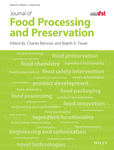Effect of hydrocolloids, sugar, and citric acid on strawberry volatiles in a gummy candy
Abstract
Hydrocolloids and additives in gummy candies can bind strawberry flavor volatiles. The type of hydrocolloid (gelatin, pectin, and starch) and the concentration of the pectin, sugar, and acid, were varied. Volatile concentrations in the headspace of the solutions containing no hydrocolloids were significantly higher than the gels that contained hydrocolloids. Gelatin produced the lowest volatile concentrations compared to pectin or starch, which were not different from each other. Increasing pectin concentration decreased volatile concentrations. Sugar had the greatest effect on volatile concentration in the headspace. Increasing sugar content from 0 to 55% caused the volatile release to drop significantly. However, further increasing sugar from 55 to 74% produced either an increase or decrease, depending on the volatile. pH 3.86 had the greatest volatile release for most volatiles, and decreasing the pH from 3.65 to 3.47 further decreased the headspace concentration of volatiles. Hardness alone had no significant effect on flavor release.
Practical applications
Reformulation of gummy gels may change the perceived flavor level unless the concentration of flavor extract is adjusted. Sugar had the greatest effect on volatile release, followed by acid content. Type and concentration of hydrocolloid also had some effect.




